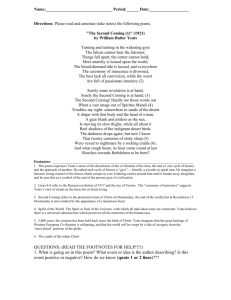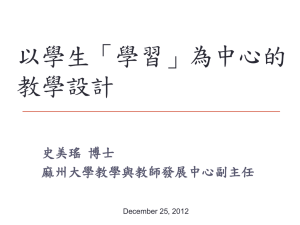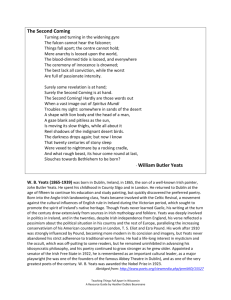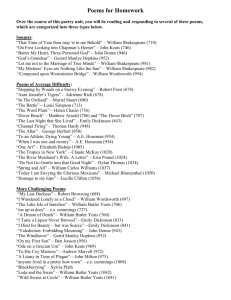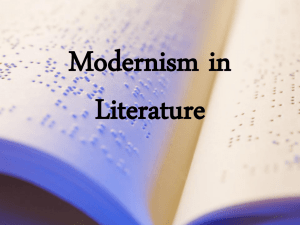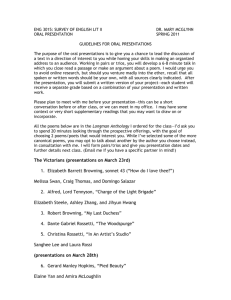WILLIAM BUTLER YEATS: THE MASTER OF SYMBOLS
advertisement
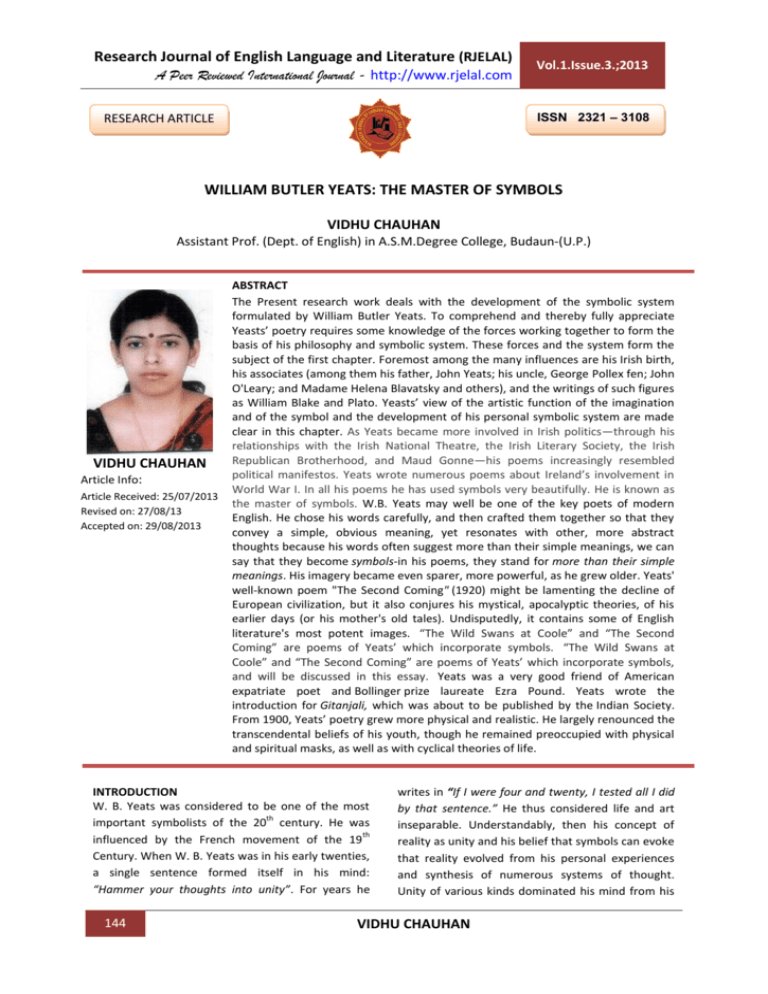
Research Journal of English Language and Literature (RJELAL) A Peer Reviewed International Journal - http://www.rjelal.com Vol.1.Issue.3.;2013 ISSN 2321 – 3108 RESEARCH ARTICLE WILLIAM BUTLER YEATS: THE MASTER OF SYMBOLS VIDHU CHAUHAN Assistant Prof. (Dept. of English) in A.S.M.Degree College, Budaun-(U.P.) VIDHU CHAUHAN Article Info: Article Received: 25/07/2013 Revised on: 27/08/13 Accepted on: 29/08/2013 ABSTRACT The Present research work deals with the development of the symbolic system formulated by William Butler Yeats. To comprehend and thereby fully appreciate Yeasts’ poetry requires some knowledge of the forces working together to form the basis of his philosophy and symbolic system. These forces and the system form the subject of the first chapter. Foremost among the many influences are his Irish birth, his associates (among them his father, John Yeats; his uncle, George Pollex fen; John O'Leary; and Madame Helena Blavatsky and others), and the writings of such figures as William Blake and Plato. Yeasts’ view of the artistic function of the imagination and of the symbol and the development of his personal symbolic system are made clear in this chapter. As Yeats became more involved in Irish politics—through his relationships with the Irish National Theatre, the Irish Literary Society, the Irish Republican Brotherhood, and Maud Gonne—his poems increasingly resembled political manifestos. Yeats wrote numerous poems about Ireland’s involvement in World War I. In all his poems he has used symbols very beautifully. He is known as the master of symbols. W.B. Yeats may well be one of the key poets of modern English. He chose his words carefully, and then crafted them together so that they convey a simple, obvious meaning, yet resonates with other, more abstract thoughts because his words often suggest more than their simple meanings, we can say that they become symbols-in his poems, they stand for more than their simple meanings. His imagery became even sparer, more powerful, as he grew older. Yeats' well-known poem "The Second Coming" (1920) might be lamenting the decline of European civilization, but it also conjures his mystical, apocalyptic theories, of his earlier days (or his mother's old tales). Undisputedly, it contains some of English literature's most potent images. “The Wild Swans at Coole” and “The Second Coming” are poems of Yeats’ which incorporate symbols. “The Wild Swans at Coole” and “The Second Coming” are poems of Yeats’ which incorporate symbols, and will be discussed in this essay. Yeats was a very good friend of American expatriate poet and Bollinger prize laureate Ezra Pound. Yeats wrote the introduction for Gitanjali, which was about to be published by the Indian Society. From 1900, Yeats’ poetry grew more physical and realistic. He largely renounced the transcendental beliefs of his youth, though he remained preoccupied with physical and spiritual masks, as well as with cyclical theories of life. INTRODUCTION W. B. Yeats was considered to be one of the most th important symbolists of the 20 century. He was th influenced by the French movement of the 19 Century. When W. B. Yeats was in his early twenties, a single sentence formed itself in his mind: “Hammer your thoughts into unity”. For years he 144 writes in “If I were four and twenty, I tested all I did by that sentence.” He thus considered life and art inseparable. Understandably, then his concept of reality as unity and his belief that symbols can evoke that reality evolved from his personal experiences and synthesis of numerous systems of thought. Unity of various kinds dominated his mind from his VIDHU CHAUHAN Research Journal of English Language and Literature (RJELAL) A Peer Reviewed International Journal - http://www.rjelal.com youthful involvement in the movement and Irish nationalism to his later efforts to achieve “Unity of Being” through poetry. During his youth he hoped to help unify Ireland by gathering together his literature – The Fairy Tales, Legends & Myths. Yeats writes: As a young he had three interests: “in the form of literature; in the form of philosophy & a belief in Nationality.” DISCUSSION W. B. Yeats (1865-1939) was very influenced by the French symbolist movement and he is often regarded as the most important symbolist poet of the twentieth century. Yeats felt 'metaphors are not profound enough to be moving,' so his poems heavily incorporate symbols as a means of expressing abstract and mystical ideas. He is famous for his symbolism in English Literature. His symbols are very famous. He was aware of the symbolic value of an Irish winner so soon after Ireland had gained independence, and sought to highlight the fact at each available opportunity. His reply too many of the letters of congratulations sent to him contained the words: "I consider that this honor has come to me less as an individual than as a representative of Irish literature, it is part of Europe's welcome to the Free State." Yeats used the occasion of his acceptance lecture at the Royal Academy of Sweden to present himself as a standard-bearer of Irish nationalism and Irish cultural independence His Kinsmen’s devotion to Ireland & Contempt for the English was also observed by him: “Everyone I knew well in Sligo despised Nationalists & Catholics, but all disliked England with a prejudice that had come down perhaps from the days of the Irish Parliament. I knew stories to the discredit of England & took them all seriously”. His poems incorporated symbols as a means of representing mystical, dream like & abstract ideas. . There are so many poems in English Literature in which he has used so many symbols. He has used symbols at an appropriate place in his poems. In his poem “A Prayer for My Daughter”, he has criticized the beautiful ladies like Helen and said that beautiful ladies eat “crazy salad.” “The Wild Swans at Coole” & “The Second Coming” are poems of Yeats which in-corporate symbols and will be discussed in his essay. 145 Vol.1.Issue.3.;2013 In “A Vision” Yeats speaks of “Gyres” as his term for a spiraling motion in the shape of a cone. These gyres are important symbols in the poetry of Yeats and especially in ‘The Second Coming’, being mentioned in the very first line. The gyres function as a symbol alluding something which could be subjective the reader. It could be prophetically interpreted to mean that mankind and life itself is spiraling into self-destruction. This idea is reflected in the first few lines of the poem:“The falcon cannot hear the Falconer; Things fall apart; the centre cannot hold; Mere anarchy is loosed upon the world”. The symbol of the gyre is being continued through the image of the falcon, as it spirals above the falconer, getting further and further from the centre until eventually the falcon cannot hear the calls of its master. The phrase “Things fall apart” could easily be interpreted as referring and to destruction of the physical world itself, and the use of the verb “loosed” is effective. Some poetry critics and most readers who are a bit confused by W. B. Yeats' poems would call him the "master of symbolism." He uses the mechanisms of poetry-rhythm, rhyme, and meter-along with the use of both emotional and intellectual symbols to express emotion and higher meaning in a usually short and concise length of words. His theories on rhythm and use of symbols are evident in his work, especially in such pieces as "The Second Coming," "The Valley of the Black Pig," and "No Second Troy," and Yeats' feelings toward emotion and the symbols and words that invoke them make both he and his work unique. In Yeats' essay "The Symbolism of Poetry," he explains his theory of how rhythm, rhyme, and meter should be properly applied in poetry. Of rhythm, he says that it should be musical. Throughout his poetry there is an underlying rhythm and meter; he uses it in a way that makes its presence come secondary to the ease of reading the poem naturally. He does this with "The Second Coming" and "The Valley of the Black Pig." In places, through variation in rhythm, it is obvious that he is more worried about the content of the poem than any particular meter. Lines such as:"Surely some revelation is at hand; VIDHU CHAUHAN Research Journal of English Language and Literature (RJELAL) A Peer Reviewed International Journal - http://www.rjelal.com Surely the Second Coming is at hand. The Second Coming! Hardly are those words out..." and "The dews drop slowly and dreams gather: unknown spears Suddenly hurtle before my dream-awakened eyes..." (Poems of W.B. Yeats 1). These lines show examples of this. Yeats explains in his own words, "The purpose of rhythm...is to prolong the moment of contemplation, the moment when we are both asleep and awake, which is one moment of creation, by hushing us with an alluring monotony, while it holds us waking by variety..." What Yeats means is that rhythm lulls us into a trance, as he says later, "...to keep us in that state of perhaps real trance, in which the mind, liberated from the pressure of the will is unfolded in symbols" ("The Symbolism of Poetry" 159). So Yeats believes that a natural, musical rhythm, through this state of trance that it induces, helps the mind reach a dreamlike state in which everything is expressed and understood in symbols and understood more purely than if the logical side of the mind were to "pick" at the poem. Thus, his use of symbols is justified in one way through his preference of a looser rhythm. Rhyme, Yeats explains in his essay, is used best for memory's sake. In this way it is believed he means for rhyme to be recursive and to draw a connection between one line or lines and another. The rhyming words cause the brain to inadvertently recall the line or lines before it that rhymed with the last line they have read. The motion of this recursive rhyming theory can be seen as a needle sews in a loop, two stitches forward and one stitch back, weaving a story fragment and an emotion into the mind of the reader ("The Symbolism of Poetry" 153-159). Also in the same essay, Yeats describes symbolism in many different ways: as the "language" of dreams, as emotional or intellectual, and as an ever-changing level of meaning that differs from person to person and time period to time period. He believes that these images evoked by symbols are what the essence of poetry should be, that a poem should not merely have one meaning, but many meanings to many people of different times. Throughout almost all of his poetry there are symbols to be felt or interpreted. One type of symbol he writes about in his essay is an emotional symbol. An example of an emotional symbol is the use of the word purple to 146 Vol.1.Issue.3.;2013 describe hills or clouds; it gives a serine feeling but also perhaps a sad feeling, though for no particular, logical reason. The second type of symbol Yeats writes about is an intellectual symbol; this is a symbol that stands for something and its meaning is learned, such as, the cross standing for forgiveness or Jesus, or a white lily standing for purity. Yeats says that intellectual symbols are the most effective because they convey depths of meaning rather than just a general feeling or nostalgia. He says, "It is the intellect that decides where the reader shall ponder over the procession of symbols, and if the symbols are merely emotional, he gazes from amid the accidents and destinies of the world; but if the symbols are intellectual too, he becomes himself a part of pure intellect...If I watch a rusty pool in the moonlight, my emotion at its beauty is mixed with memories...but if I look at the moon herself and remember any of her ancient names and meanings, I move among divine people..." ("The Symbolism of Poetry" 161). For example, Yeats' poem "The Second Coming;" in this poem there are the symbols gyre, falcon and falconer, lion body, rocking cradle, and Bethlehem, just to name a few. Each of these is an intellectual symbol, and, depending on the person's individual knowledge, can be interpreted differently and some are only linked to one thing, such as Bethlehem, which can only be linked to the city of the same name and specific historical or religious meaning. Yeats' poetry is very dreamlike in its symbols and allusions and in the emotional colors that those symbols paint in the reader's mind. This creates deep levels of meaning to his poems. If a poem, such as "No Second Troy," is read lightly it gives off a simple emotion from its wording and subject matter. But with deeper study into the history of both Yeats and the poem, one learns who the woman is that he speaks of and why he says such things of her as "[She has] taught to ignorant men most violent ways, Or hurled the little streets upon the great..." and "With beauty like a tightened bow, a kind That is not natural in an age like this,..." ("Poems of W. B. Yeats 1). VIDHU CHAUHAN Research Journal of English Language and Literature (RJELAL) A Peer Reviewed International Journal - http://www.rjelal.com However, on another level, one could see a comparison and contrast of the woman in the poem and Helen of Troy. It is said about Helen that she was the cause of Trojan War. Through the poem ‘No Second Troy’, he symbolically criticized his beloved Maud Gonne who had rejected the love proposal of W.B Yeats. CONCLUSION Thus it can be concluded that W.B.Yeats is really the master of symbols. The symbols which are used by him in his poems are world famous. It is said about him that he was highly inspired by “Bhagavata Gita.” Certainly Yeats knows his theories on symbolism in poetry and how to apply them. He shows these qualities in his own work through mechanics and content. The ideas of his essay clearly define and influence his poetry and his perspective of it. Clearly he is a master of symbolism even among his peers. Perhaps one of the effects of his knowledge of symbols is that the moon may be more than just a moon, and a flower more than a flower. WORKS CITED Yeats,W.B., Explorations (New York: The McMillan Company, 1962)P. 263. Yeats,W.B., Four Years: 1887 to 1891 in ‘The Autobiography of W. B. Yeats,’ Collier Books (New York: The McMillan Company, 1969) P. 128.Ibid, P.20 Ibid, P.21 Yeats, W.B. "Poems of W. B. Yeats." "No Second Troy." Handout. Dr. J. Whitsitt. September 2006. Pg. 1. Yeats, W. B. "Poems of W. B. Yeats." "The Second Coming." Handout. Dr. J. Whitsitt. September 2006. Pg. 1. Yeats, W.B. "Poems of W. B. Yeats." "The Valley of the Black Pig." Handout. Dr. J. Whitsitt. September 2006. Pg. 1 Yeats, W. B. "The Symbolism of Poetry." Handout. Dr. J. Whitsitt. September 2006. Pgs. 153-164. . 147 Vol.1.Issue.3.;2013 VIDHU CHAUHAN
